Biology
- Mutualism, Parasitism, Commensalism
What are Mutualism, Parasitism and Commensalism? Mutualism is a relationship between organisms of different species in which both benefit from the relationship. For example, bees and flowers. The bees help pollinate the flowers for reproduction...
- Pollen: Evolution
In this picture is pollen that got stuck to the ground because of juice or water. Pollen has been flying around because plants and flowers are blooming and they are ready to fertilize. Pollen is like a tiny grain inside id a seed plant which usually...
- Asexual Reproduction: Evolution
It is the spring season and flowers are blooming. When flowers bloom they release pollen into the air to create more flowers! Pollen is essentially the sperm of the flower and as it travels through the air it will eventually reach another flower...
- Form Follows Function - It?s About Time
Biology concepts ? circadian rhythm, vision sense, adaptation, parasitism, form follows function The sun and the moon are symbols of differentactivity cycles. As with everything else, we have to givethem human characteristics (anthropomorphism).Many...
- The Perils Of Plant Monogamy
Biology concepts ? pollination, single pollinator, co-evolution, co-divergence What?s bugging her, it?s supposed to be a party!Imagine the best party of the year ? it?s cold outside, but hot inside. The food is great, all your friends are there, everyone...
Biology
Sunrise, Sunset ? Life In the Twilight
Biology concepts ? activity patterns, crepuscular, co-evolution, active pollination
Nocturnal and diurnal activity patterns are like vanilla and chocolate cupcakes. But what if you like rose hip or green tea flavors ? are there cupcakes out there for you?
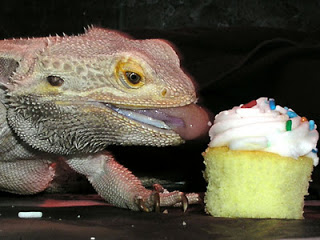 |
Who knew lizards like cupcakes. I bet they just lick off the icing. |
In a word ? yes. In fact, there are so many organisms that are neither nocturnal nor diurnal that I hesitate to call them exceptions ? like how everyone has mocha cupcakes now. And I bet you know some of animals with extraordinary activity?? ever heard of sweat bees or deer or infants?
Diurnal animals have developed color vision and ways to deal with the heat and the sun. Nocturnal animals have sensitive vision and other adaptations to make use of the dark. But there are some animals that are active on the edges of both situations; dawn and dusk. What adaptations would help an animal succeed in this niche?
In general, crepuscular (latin for twilight) animals have vision most like nocturnal animals. A tapetum lucidum (Form Follows Function) is present behind the retinas of many crepuscular mammals. Your cat is crepuscular, although she will adapt to a diurnal pattern as a pet?..if she feels like it, you know how cats are.
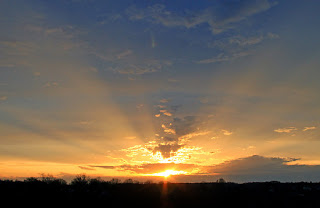 |
Those great light shows put on by nature in the evenings have a name ? crepuscular rays. Impressive trivia for your next party. Photo by van049. |
There are advantages to crepuscularness (I just now invented that word). By curtailing activity during the heat of the day, less energy is spent conserving water. Not surprisingly, many desert species are crepuscular. Heat, on the other hand, doesn?t seem to be as much of an issue, since there are endothermic as well as ectothermic species that are active in these time frames, for instance desert lizards like the gila monster.
The dim light available at dawn and dusk is also an advantage for crepuscular animals. There may be enough light to see, but not enough to make these animals stick out like a sore thumb. This works for deer; along with their coloring, the dim light helps them blend into the background. Deer caught out during the day become very stressed and confused. They may end up playing in traffic; just a case of clouded judgment due to sunshine.
The aim of the crepuscular pattern is often to reduce the chance of being eaten. Most terrestrial predators are diurnal or nocturnal (except for several cat species), so crepuscular animals are active after diurnal predators have had their warm milk, and before nocturnal animals drink their coffee.
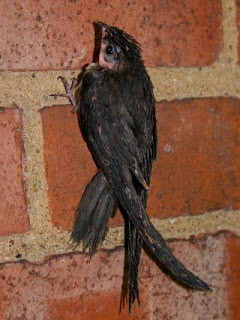 |
Chimney swifts perch on vertical surfaces and have saliva that dries like glue and is practically insoluble. They use it to build nests on chimney walls. They have weak claws and can?t perch on branches, they can perch on vertical surfaces using their stiff tail feathers, but mostly they just fly 16-18 hours each day. |
Slightly more common are the crepuscular birds, including the American woodcock, which is a ground bird that eats worms and nests in brushy young forests. The chimney swift is also crepuscular, but it nests in chimneys and other vertical surfaces, eats insects out of the air, and can maintain flight for an entire year. These are birds with very different behaviors, diets, and ranges, but are both crepuscular. As is the rule in nature - maybe the only rule without an exception - it is impossible to predict the behavior of one species based on characteristics similar to other species.
In the plant/pollinator part of the community, some crepuscular pollinators have developed special relationships with plants that flower in the evening only. This represents a special form of crepuscularness (there?s that new word again, I think it will catch on) called vespertinal (vesper = evening in latin) activity. These plants and insects are active only in the evening, and often co-evolve mutualistic relationships.
In the desert where the Joshua tree lives, water is at a premium, and the heat doesn?t help the water situation. Remember in our discussion of nastic movements (Plants that Don?t Sleep) we saw that turgor pressure of water is responsible for the opening of the flowers. But open flowers promote water evaporation! Therefore, the best strategy for the Joshua tree is to have its flowers open outside the heat of the day. Et voila - it is vespertinal.
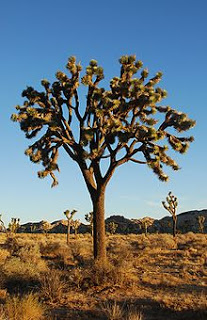 |
Joshua trees are native to the Mojave desert. They were named by the Mormon settlers who were reminded of Joshua raising his arms in prayer. Predictions are that 90% of the trees could be wiped out by global warming by the year 2100. |
The price of water also has also driven the Joshua tree to produce no nectar ? it must have some other way to attract the yucca moth. It is the yucca moth who really taken this upon its (her) shoulders. She has found a way to make pollinating the Joshua tree flowers pay off for her species. But only the yucca moth has made this connection, and this makes their relationship an exception to a biological rule.
Since they are available to one another in the same part of the day (evening) it is more likely that vespertine plants might have a single pollinator, which we learned a few weeks ago (The Perils Of Plant Monogamy) is the exception to the rule of multiple pollinators.
The female yucca moth is not drawn to the flowers by nectar, but by the need to propagate her species. At one flower, the female moth gathers pollen and balls it up into a large mass. Palps (appendages like arms but located near the mouth) hold the pollen ball as she travels to another Joshua tree; almost always to another tree. We know that cross-pollination is better than self-pollination (Is It Hot In Here), but the question remains, how does the moth know that?
At a second tree, the yucca moth lays an egg inside the carpal (which houses the ovule and is where the seeds will form once the flower is pollinated), but only in one or two of the many caprals. Then the moth swipes the pollen ball over the stigma (the top of the carpals), ensuring that the seeds will develop.
Most pollinators are passive, they transfer pollen as a result being drawn by some attractor (nectar, odor, color, etc.). Pollen transfer is not the reason for their visits. But yucca moths are an exception to this rule; they are active pollinators. They visit the flowers with the express intent of collecting and transferring pollen. But why spend energy to purposefully pollinate?
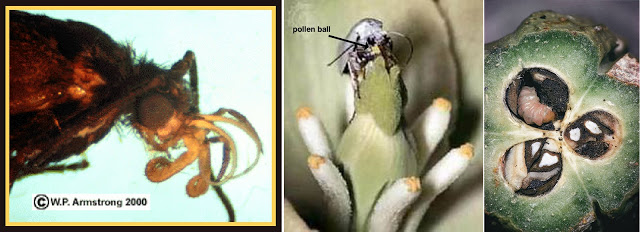 |
In the left image, you can see the palps that the yucca moth uses to gather up a pollen ball. These are modified mouth parts, and mouth parts are modified ancient legs. The middle image shows the yucca moth actively pollinating the flower after it laid its egg inside the carpal. The right image shows the larvae growing inside one ovule tube (the top-left cavity), eating the seeds as food. |
The seeds are the payoff. The moth larva eats the seeds of that one carpal while developing. This is symbiotic mutualism, both species benefit from their relationship ? food for the moth larva, and sure pollination for the Joshua tree.
But certain precautions must be taken. Production of seeds (and fruit) takes energy. If the flower won?t produce enough seeds to make it worth the energy expenditure, the tree will abort the flower. So, if moths deposit eggs in too many carpals of the same flower, the larvae will eat too many seeds, and the flower will commit suicide. This will kill the larvae as well. To prevent this, the moths emit a chemical scent to indicate that a flower has been visited and pollinated; other moths will move on to flowers that have not been marked as occupied.
The yucca plants and yucca moth are an example of the vespertine lifestyle, but are there organisms that live exclusively on the other edge of the night? Yep.
Several types of bees are active only in the early morning hours, just after sunrise. This type of activity pattern is called matutinal (Matuta, the Roman goddess of dawn). Some flowers open up very early in the morning, and these are the targets of matutinal bees. The morning glory is a good example, although the flowers remain open long after the early bird bees have gone to bed.
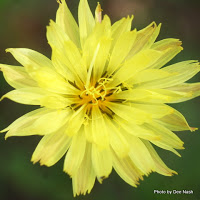 |
This is the false dandelion. Sweat bees and schinia moths appreciate for giving them food and helping in reproduction. I appreciate it for not being a true dandelion? the lawn care expert?s mortal enemy! |
Other matutinal flowers include the plants of the pyrrhopappus family. These are perennial herbs of the American southwest, south central, and southeast grass lands, and include the carolinus species that is called a false dandelion. They flower for two-four days a year, opening at sunrise and closing by 10:00 am on a hot, sunny day.
The matutinal flower moth (schinia mitis) and the sweat bee (Hemihalictus lustrans) have relationships with the pyrrhopappus plants. The bees use them as their exclusive source of pollen, although they must visit other flowers, like the morning glory, for nectar.
The Schinia mitis moth is more dependent on pyrrhopappus than are the sweat bees. Food, shelter, mating, and a place to lay eggs are all supplied by these specific herbs, as well as shelter and a food source for the larvae. The moths mate on the open flowers between 7:00 am and 9:45 am (rain or shine), and the female then lays the eggs deep within flower.
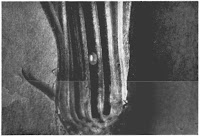 |
The mitis moth egg is laid deep within the false dandelion flower for protection. Its going to cramped quarters for the larva. |
The reason for flowers developing a matutinal lifestyle might be similar to those for vespertine or fully crepuscular species, ie, water and energy savings. But the pollinators, especially the bees, seem to have followed suit for other reasons. True sweat bees (many people misidentify them) take advantage of the early morning hours to avoid the lines at the flowers; it is a simple matter of reduced competition. On the other hand, the mitis moth has co-evolved with the flower and become completely dependent upon it. If the flower is open only in the morning, the moth better be ready on time.
Who knew that so many plants and animals had thrown off the yoke that tethered them to either day or night activity, and now work at the edges of both? Next time we will take it even further; some organisms have stopped working on any schedule at all.
Chen Y, & Seybold SJ (2014). Crepuscular flight activity of an invasive insect governed by interacting abiotic factors. PloS one, 9 (8) PMID: 25157977
Rockhill, A., DePerno, C., & Powell, R. (2013). The Effect of Illumination and Time of Day on Movements of Bobcats (Lynx rufus) PLoS ONE, 8 (7) DOI: 10.1371/journal.pone.0069213
Chen Y, & Seybold SJ (2014). Crepuscular flight activity of an invasive insect governed by interacting abiotic factors. PloS one, 9 (8) PMID: 25157977
Rockhill, A., DePerno, C., & Powell, R. (2013). The Effect of Illumination and Time of Day on Movements of Bobcats (Lynx rufus) PLoS ONE, 8 (7) DOI: 10.1371/journal.pone.0069213
For more information, classroom activities, or laboratories on crepuscular activity, yucca moth reproduction, or Schinia mitis moth reproduction, see:
Crepuscular activity ?
www.emnrd.state.nm.us/prd/.../5thGradeAnimalAdaptations.ppt
http://www.bio.davidson.edu/people/midorcas/animalphysiology/websites/2010/Pacious/DiurnalNocturnalCrep.htm
http://www.circadian.org/dictionary.html
http://www.enotes.com/topic/Vespertine_%28biology%29
http://www.gleaming.org/crepuscular/
http://yomi.mobi/egate/Crepuscular/a
Yucca and yucca moths ?
http://waynesword.palomar.edu/ww0902a.htm
http://indianapublicmedia.org/amomentofscience/yucca-flowers-and-yucca-moths/
http://www.emporia.edu/ksn/v41n2-june1995/KSNVOL41-2.htm
http://www.insectman.us/articles/butterflies-and-moths/yucca/yucca--plant.htm
http://www.desertusa.com/animals/yucca-moth.html
http://www.fs.fed.us/wildflowers/pollinators/pollinator-of-the-month/yucca_moths.shtml
http://bss.sfsu.edu/holzman/courses/Fall99Projects/yucca.htm
http://bss.sfsu.edu/holzman/courses/Fall99Projects/yucca.htm
http://www.blueplanetbiomes.org/joshua_tree.htm
http://www.willamette.edu/~csmith/SCRP.htm
False dandelions and moths ?
http://www.eattheweeds.com/pyrrhopappus-hypochoeris-dandelion-impostors-2/
http://www.cas.vanderbilt.edu/bioimages/species/pyca2.htm
http://www.worldfieldguide.com/wfg-species-detail.php?taxno=18360
http://www.butterfliesandmoths.org/species/Schinia-mitis
http://www.jstor.org/pss/25084173
- Mutualism, Parasitism, Commensalism
What are Mutualism, Parasitism and Commensalism? Mutualism is a relationship between organisms of different species in which both benefit from the relationship. For example, bees and flowers. The bees help pollinate the flowers for reproduction...
- Pollen: Evolution
In this picture is pollen that got stuck to the ground because of juice or water. Pollen has been flying around because plants and flowers are blooming and they are ready to fertilize. Pollen is like a tiny grain inside id a seed plant which usually...
- Asexual Reproduction: Evolution
It is the spring season and flowers are blooming. When flowers bloom they release pollen into the air to create more flowers! Pollen is essentially the sperm of the flower and as it travels through the air it will eventually reach another flower...
- Form Follows Function - It?s About Time
Biology concepts ? circadian rhythm, vision sense, adaptation, parasitism, form follows function The sun and the moon are symbols of differentactivity cycles. As with everything else, we have to givethem human characteristics (anthropomorphism).Many...
- The Perils Of Plant Monogamy
Biology concepts ? pollination, single pollinator, co-evolution, co-divergence What?s bugging her, it?s supposed to be a party!Imagine the best party of the year ? it?s cold outside, but hot inside. The food is great, all your friends are there, everyone...
